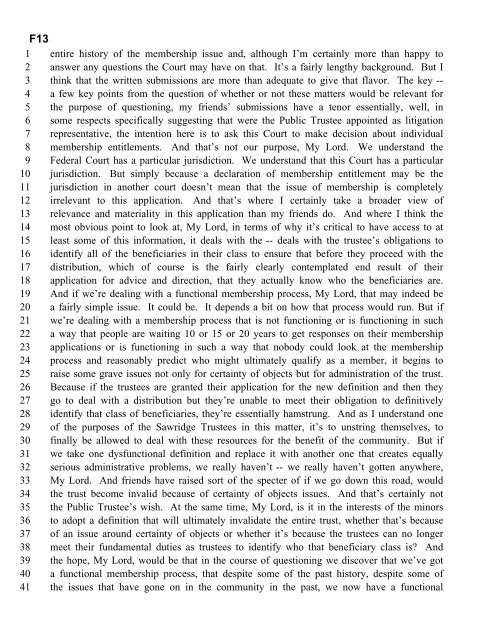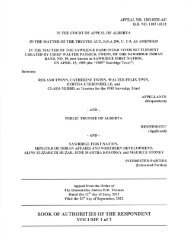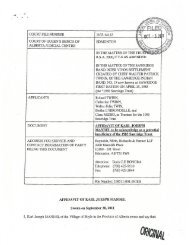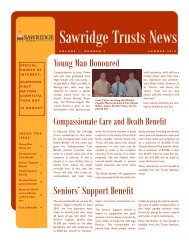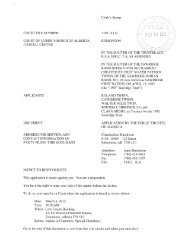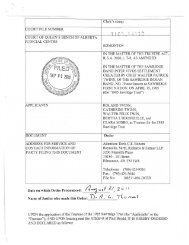31420-12-1 SAWRIDGE, Indian vs. ROLAND, Twinn et al
31420-12-1 SAWRIDGE, Indian vs. ROLAND, Twinn et al
31420-12-1 SAWRIDGE, Indian vs. ROLAND, Twinn et al
Create successful ePaper yourself
Turn your PDF publications into a flip-book with our unique Google optimized e-Paper software.
F13<br />
1 entire history of the membership issue and, <strong>al</strong>though I’m certainly more than happy to<br />
2 answer any questions the Court may have on that. It’s a fairly lengthy background. But I<br />
3 think that the written submissions are more than adequate to give that flavor. The key --<br />
4 a few key points from the question of wh<strong>et</strong>her or not these matters would be relevant for<br />
5 the purpose of questioning, my friends’ submissions have a tenor essenti<strong>al</strong>ly, well, in<br />
6 some respects specific<strong>al</strong>ly suggesting that were the Public Trustee appointed as litigation<br />
7 representative, the intention here is to ask this Court to make decision about individu<strong>al</strong><br />
8 membership entitlements. And that’s not our purpose, My Lord. We understand the<br />
9 Feder<strong>al</strong> Court has a particular jurisdiction. We understand that this Court has a particular<br />
10 jurisdiction. But simply because a declaration of membership entitlement may be the<br />
11 jurisdiction in another court doesn’t mean that the issue of membership is compl<strong>et</strong>ely<br />
<strong>12</strong> irrelevant to this application. And that’s where I certainly take a broader view of<br />
13 relevance and materi<strong>al</strong>ity in this application than my friends do. And where I think the<br />
14 most obvious point to look at, My Lord, in terms of why it’s critic<strong>al</strong> to have access to at<br />
15 least some of this information, it de<strong>al</strong>s with the -- de<strong>al</strong>s with the trustee’s obligations to<br />
16 identify <strong>al</strong>l of the beneficiaries in their class to ensure that before they proceed with the<br />
17 distribution, which of course is the fairly clearly contemplated end result of their<br />
18 application for advice and direction, that they actu<strong>al</strong>ly know who the beneficiaries are.<br />
19 And if we’re de<strong>al</strong>ing with a function<strong>al</strong> membership process, My Lord, that may indeed be<br />
20 a fairly simple issue. It could be. It depends a bit on how that process would run. But if<br />
21 we’re de<strong>al</strong>ing with a membership process that is not functioning or is functioning in such<br />
22 a way that people are waiting 10 or 15 or 20 years to g<strong>et</strong> responses on their membership<br />
23 applications or is functioning in such a way that nobody could look at the membership<br />
24 process and reasonably predict who might ultimately qu<strong>al</strong>ify as a member, it begins to<br />
25 raise some grave issues not only for certainty of objects but for administration of the trust.<br />
26 Because if the trustees are granted their application for the new definition and then they<br />
27 go to de<strong>al</strong> with a distribution but they’re unable to me<strong>et</strong> their obligation to definitively<br />
28 identify that class of beneficiaries, they’re essenti<strong>al</strong>ly hamstrung. And as I understand one<br />
29 of the purposes of the Sawridge Trustees in this matter, it’s to unstring themselves, to<br />
30 fin<strong>al</strong>ly be <strong>al</strong>lowed to de<strong>al</strong> with these resources for the benefit of the community. But if<br />
31 we take one dysfunction<strong>al</strong> definition and replace it with another one that creates equ<strong>al</strong>ly<br />
32 serious administrative problems, we re<strong>al</strong>ly haven’t -- we re<strong>al</strong>ly haven’t gotten anywhere,<br />
33 My Lord. And friends have raised sort of the specter of if we go down this road, would<br />
34 the trust become inv<strong>al</strong>id because of certainty of objects issues. And that’s certainly not<br />
35 the Public Trustee’s wish. At the same time, My Lord, is it in the interests of the minors<br />
36 to adopt a definition that will ultimately inv<strong>al</strong>idate the entire trust, wh<strong>et</strong>her that’s because<br />
37 of an issue around certainty of objects or wh<strong>et</strong>her it’s because the trustees can no longer<br />
38 me<strong>et</strong> their fundament<strong>al</strong> duties as trustees to identify who that beneficiary class is? And<br />
39 the hope, My Lord, would be that in the course of questioning we discover that we’ve got<br />
40 a function<strong>al</strong> membership process, that despite some of the past history, despite some of<br />
41 the issues that have gone on in the community in the past, we now have a function<strong>al</strong>


